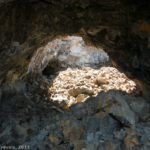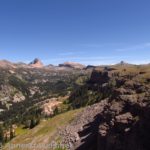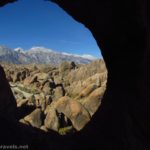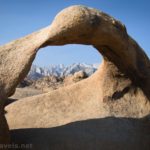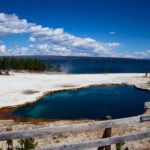
The other day, I realized that the maps in the back of the Bibles I typically use don’t bother to show the divided kingdom of Israel vs. Judah. That seemed like an oversight to me; after all, where were major cities in the Old Testament located – places like Samaria – and where was the border, anyway?
So here’s a map of Samaria (and the boundary line) in relation to Jerusalem, and then I’ll go into a little bit about the city, itself.
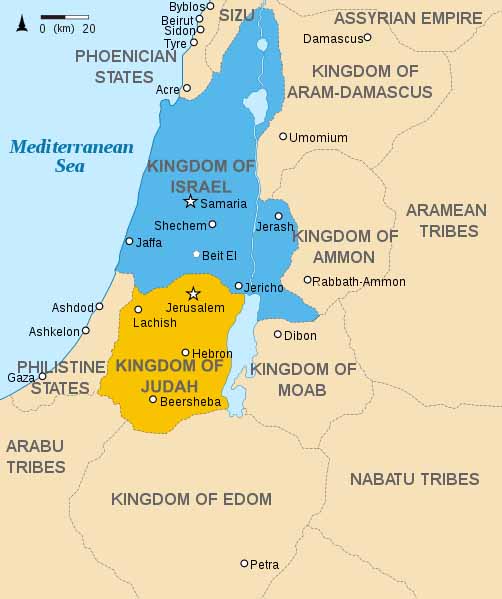
Samaria was built on a hill about 33 miles north of Jerusalem (about the distance between Dallas and Fort Worth, or Seattle to Tacoma, or Los Angeles to Malibu, or Washington, DC, to Baltimore). King Omri (the 5th king of Israel after Jeroboam) purchased the hill from Shemer in 876BC. Before he built the city on the hill, the capital of the kingdom of Israel was Tirzah (just north of Shechem on the map above). In 721BC – 155 years after Samaria was built – the Assyrians defeated the Israelites, deported them from their native land, and repopulated Samaria and the surrounding area with various other ethnic groups. (155 years is similar to the US Revolutionary War to the Great Depression.)
Events (and later history) that took place in Samaria:
1. King Ahab built an ivory palace (1 King 22:39; Amos 3:15) and a house of Baal in the city
2. Elijah told Ahab about the upcoming famine in Samaria c.860s BC.
3. Naboth’s vineyard was in Samaria (1 King 21)
4. Ahab was buried in Samaria in 852BC.

5. Jehu slayed Ahab’s 70 sons in the city
6. Ben-Hadad, the Syrian king, besieged Samaria in c.845BC. – Elisha prophesied that the famine within the city would suddenly and miraculously end.
7. King Shalmaneser and his son Sargon conquered Samaria as a way of defeating all of Israel in 721BC. At this point, the Israelites were deported and foreigners were resettled there.
8. The new inhabitants of Samaria did not worship the Lord, so He sent wild animals among them. They requested that a priest be sent back so that they would know how to worship the “god of the land.” This led to a mixed religion combining the Mosaic law with each person’s historical idol worship.

9. Sanballat worked and wrote letters from Samaria during the rebuilding of the temple after the Babylonian exile (c.450BC).
10. Alexander the Great conquered Samaria in 333BC. The Greeks moved in, and the Samaritans moved out to settle in the towns of Shechem and Mt. Gerizim.
11. In 108BC, John Hyrcanus (a Hasmonaean king) leveled the city and sold its inhabitants into slavery.
11. In 57BC, Samaria was rebuilt as a Roman city by Governor Gabinius. 27 years later, Emperor Agustus gave the city to Herod the Great. He initiated Roman reforms, including a massive temple dedicated to the god Augustus (notably, he also changed the name to Sebaste, which is the Greek word for Agustus).
12. While Jesus traveled several times through the region of “Samaria,” there is little to no mention of the city, itself, in the Gospels. At that time, the true Jews and the population of Samaritans were not on the best of terms, in part because of the Samaritans’ mixed ancestry and worship practices.
13. Philip, Peter, and John preached in Samaria after Jesus’ death and resurrection (Acts 8; about 40AD).

13. Samaria was destroyed once again about 67AD during the Jewish Wars. However, in 200AD, the Roman Emperor Septimius Severus granted that Samaria/Sebaste could become a Roman colony. 200 years later (400AD), the city had mostly converted to Christianity. It was a seat of a bishop during the early Byzantine era.
14. In 551AD, an earthquake destroyed the city. It never truly recovered.
15. In the 1100s AD, the Crusaders revived the city briefly by building a large cathedral and smaller chapel in honor of John the Baptist. (The Crusaders believed that John was beheaded in Samara; this has since been proven untrue.)
16. Today, there are extensive ruins in area around Samaria/Sebaste, protected in Samaria National Park in the West Bank.
Is there another city that you’d like to hear about? I’m hoping to do more of these deep dives in the future!





